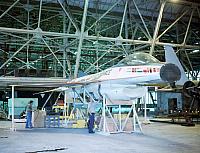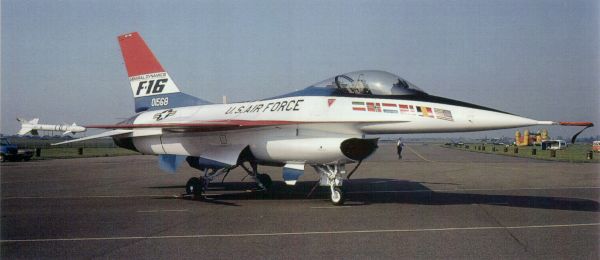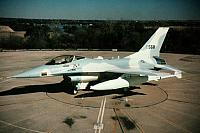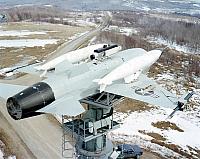Fighter Jet News
F-16 Fighting Falcon News
Legendary F-16 test pilot Neil Anderson dies
September 18, 2006 (by
Lieven Dewitte) -
Neil R. Anderson accumulated over 15,000 flight hours in over 200 types of aircraft, some of them still very much experimental. But the story that probably spawned the most legends about him involved a belly landing in an F-16.
It happened at Carswell Air Force Base on 08 May 1975 when the YF-16 prototype developed by General Dynamics was competing for a next-generation lightweight fighter contract with the Defense Department. Mr. Anderson, a General Dynamics test pilot, had YF-16 No. 2 (#72-1568) out for a practice demo for the Paris Air Show when one of the main gear tires got stuck in the landing gear wheel well.
He flew around until he was almost out of gas and then came in for a wheels-up landing on the grass besides the runway. Damage was surprisingly light, and Mr. Anderson walked away unharmed.
"When it finally stopped, he jumped out of the cockpit and ran about 50 yards and threw his helmet on the ground," Retired Air Force Brig. Gen. Bob Efferson said. "You don't belly in modern-day fighters, but he did it. He did a remarkable job."
It was the first real mishap in the YF-16 program's brief history and Paris was definitely out for ship No. 2 (No. 2 now resides at Rome Air Development Center in New York state.).
Shortly after the belly landing, YF-16 No. 1 made the first transatlantic flight for the Viper. Together with pilots Jim Rider and Lt. Col. Duke Johnston, Mr. Anderson took the F-16 to 38 air shows in nine European countries in 50 days, including the famous Paris air show.
The rest of the story is well-known, the F-16 went on to become the best-selling jet fighter in history.
"He probably saved the F-16 program," said John Fergione, F/A-22 experimental test pilot. "He saved the airplane because he did not eject out of it. I'd never heard of [a belly landing] in a jet before. I've seen the video several times. It was spectacular."
Mr. Anderson died Monday morning at Baylor All Saints Medical Center of cancer. He was 72.
Born Dec. 2, 1933, in Omaha, Neb., the son of a career Army soldier, Mr. Anderson planned to enter the priesthood. Then one day in college he met a Navy pilot.
"That was the end of priesthood and Creighton University," he told the Star-Telegram in 1996. "I said, 'I'm flying.'"
He entered the Marine Corps as a pilot, flying active duty for five years until 1958. During that period he flew the Douglas AD-5 Sky raiders and Grumman F9F-6P and -8P.
He later went from active duty to the reserves (eventually retiring in 1974 as a lieutenant colonel) and into the mainstream aviation market working for Convair, designing Atlas missile silos, at the Chrysler Corporation's Space Division as a rocket design engineer on the Saturn 1B, at NASA training astronauts
He earned a degree in aeronautical engineering in 1961 from St. Louis University. In 1967, Mr. Anderson joined General Dynamics - now Lockheed Martin - which sent him to the test pilot school at Edwards Air Force Base, Calif.
He flew versions of the F-111 Aardvark for several years, but he clearly made his name with how he flew the F-16 in air shows.
Mr. Anderson was no hot dog but a pilot deeply committed to safety, one who lived the cliché that there are old test pilots and bold test pilots but there are no old, bold test pilots.
Mr. Anderson belonged to the Society of Experimental Test Pilots for 36 years and was active in the group, promoting air safety and contributing to aeronautical advancement. He had a legendary name even with Soviet test pilots.
Mr. Anderson has been involved in Air Racing since the late 1970's competing at the Reno National Championship Air Races in the Unlimited Class. In 1983, he won the prestigious unlimited air race championship flying a highly modified Sea Fury 426 mph.
Mr. Anderson had friends all over the globe. He carried not a whiff of cockiness, and he could make anyone feel at ease.
"He was a lot more extroverted than me," said Phil Oestricher, the first man to fly the YF-16. "He liked to be around people. I'd rather do the technical stuff. We were a good team."
After retiring in 1996 from Lockheed Martin, where he had become an executive in international marketing and business development, Mr. Anderson continued to fly. He owned a hangar at Hicks Field and founded a group of pilots that owned three T-28 Trojan trainers that they flew in air shows.
He flew around until he was almost out of gas and then came in for a wheels-up landing on the grass besides the runway. Damage was surprisingly light, and Mr. Anderson walked away unharmed.
"When it finally stopped, he jumped out of the cockpit and ran about 50 yards and threw his helmet on the ground," Retired Air Force Brig. Gen. Bob Efferson said. "You don't belly in modern-day fighters, but he did it. He did a remarkable job."
It was the first real mishap in the YF-16 program's brief history and Paris was definitely out for ship No. 2 (No. 2 now resides at Rome Air Development Center in New York state.).
Shortly after the belly landing, YF-16 No. 1 made the first transatlantic flight for the Viper. Together with pilots Jim Rider and Lt. Col. Duke Johnston, Mr. Anderson took the F-16 to 38 air shows in nine European countries in 50 days, including the famous Paris air show.
The rest of the story is well-known, the F-16 went on to become the best-selling jet fighter in history.
"He probably saved the F-16 program," said John Fergione, F/A-22 experimental test pilot. "He saved the airplane because he did not eject out of it. I'd never heard of [a belly landing] in a jet before. I've seen the video several times. It was spectacular."
Mr. Anderson died Monday morning at Baylor All Saints Medical Center of cancer. He was 72.
Born Dec. 2, 1933, in Omaha, Neb., the son of a career Army soldier, Mr. Anderson planned to enter the priesthood. Then one day in college he met a Navy pilot.
"That was the end of priesthood and Creighton University," he told the Star-Telegram in 1996. "I said, 'I'm flying.'"
He entered the Marine Corps as a pilot, flying active duty for five years until 1958. During that period he flew the Douglas AD-5 Sky raiders and Grumman F9F-6P and -8P.
He later went from active duty to the reserves (eventually retiring in 1974 as a lieutenant colonel) and into the mainstream aviation market working for Convair, designing Atlas missile silos, at the Chrysler Corporation's Space Division as a rocket design engineer on the Saturn 1B, at NASA training astronauts
He earned a degree in aeronautical engineering in 1961 from St. Louis University. In 1967, Mr. Anderson joined General Dynamics - now Lockheed Martin - which sent him to the test pilot school at Edwards Air Force Base, Calif.
He flew versions of the F-111 Aardvark for several years, but he clearly made his name with how he flew the F-16 in air shows.
Mr. Anderson was no hot dog but a pilot deeply committed to safety, one who lived the cliché that there are old test pilots and bold test pilots but there are no old, bold test pilots.
Mr. Anderson belonged to the Society of Experimental Test Pilots for 36 years and was active in the group, promoting air safety and contributing to aeronautical advancement. He had a legendary name even with Soviet test pilots.
Mr. Anderson has been involved in Air Racing since the late 1970's competing at the Reno National Championship Air Races in the Unlimited Class. In 1983, he won the prestigious unlimited air race championship flying a highly modified Sea Fury 426 mph.
Mr. Anderson had friends all over the globe. He carried not a whiff of cockiness, and he could make anyone feel at ease.
"He was a lot more extroverted than me," said Phil Oestricher, the first man to fly the YF-16. "He liked to be around people. I'd rather do the technical stuff. We were a good team."
After retiring in 1996 from Lockheed Martin, where he had become an executive in international marketing and business development, Mr. Anderson continued to fly. He owned a hangar at Hicks Field and founded a group of pilots that owned three T-28 Trojan trainers that they flew in air shows.
In Memoriam
Additional images:


Workmen inspect the fuselage of the second YF-16 aircraft (#01568) upon its arrival at Hangar no. 101 on September 27th, 1980. The aircraft will be modified for testing as an F-16 at the Rome ADC Newport Site. The effect of various weapons configurations on the aircraft`s antennas will be evaluated. [USAF photo]



